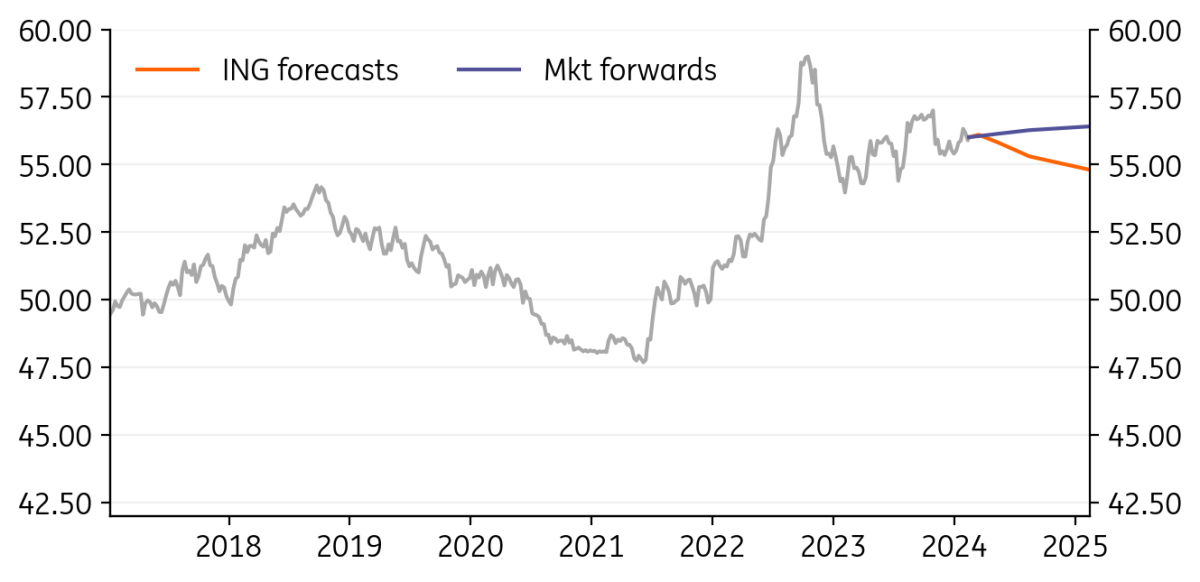FXFX Talking
Asia FX Talking: Chinese stimulus in focus
When Chinese markets re-open after the Lunar New Year, the focus will be on stimulus, be it rate cuts from the PBoC or fiscal stimulus from the government. Nobody expects a quick turnaround in the Chinese economy, but we expect 7.30 to continue proving a line in the sand for USD/CNY and the broader dollar trend to carry it lower in the second half of the year
Main ING Asia FX forecasts
| USD/CNY | USD/KRW | USD/INR | ||||
| 1M | 7.23 | ↑ | 1325.00 | ↓ | 83.00 | → |
| 3M | 7.15 | ↑ | 1300.00 | ↓ | 83.00 | → |
| 6M | 7.08 | ↑ | 1280.00 | ↓ | 83.00 | → |
| 12M | 6.90 | ↓ | 1225.00 | ↓ | 82.50 | → |
USD/CNY: PBOC easing bias could cause near term weakness
|
Spot
|
One month bias | 1M | 3M | 6M | 12M |
|---|---|---|---|---|---|
|
USD/CNY
7.1936
|
Mildly Bullish | 7.23 | 7.15 | 7.08 | 6.90 |
- The CNY weakened over the past month from around 7.10 at the start of the year to nearly 7.20 in early February, as markets speculated the PBoC would cut rates in January. While this did not materialize, the PBoC did deliver a 50bp RRR cut.
- Economic momentum was soft to start the year, and it is possible we could see further monetary easing in the next month, which adds to the short-term depreciation bias.
- In subsequent months, an expected recovery of sentiment or fundamentals, as well as the start of global rate cuts would be potential catalysts for CNY appreciation.

Refinitiv, ING
USD/KRW: KRW will gain only if a clear signal of US monetary easing
|
Spot
|
One month bias | 1M | 3M | 6M | 12M |
|---|---|---|---|---|---|
|
USD/KRW
1330.30
|
Neutral | 1325.00 | 1300.00 | 1280.00 | 1225.00 |
- The KRW fluctuated between 1,290-1,340 despite the recent robust recovery in exports. The market seemed concerned that tight liquidity conditions might trigger defaults in the property market if the restrictive monetary policy continues.
- Inflation eased to 2.8% YoY in January and is expected to move further down due to base effects in the first quarter of the year. However, it could bounce back in 2Q24 once various government measures to curb prices end.
- The KRW will likely stay in 1,300 - 1,325 range in the near term and we expect clearer appreciation trends from the second quarter.

Refinitiv, ING
USD/INR: RBI leaving inflows unsterilised
|
Spot
|
One month bias | 1M | 3M | 6M | 12M |
|---|---|---|---|---|---|
|
USD/INR
83.02
|
Neutral | 83.00 | 83.00 | 83.00 | 82.50 |
- There isn’t much to add on the virtually fixed INR since last month, though the rupee has gained slightly against the USD, despite the recent tendency for the USD to appreciate as March cuts were priced out.
- Capital inflows ahead of this year’s inclusion of Indian government bonds into the JPM global bond index may be helping the INR to make gains near-term.
- Perhaps to limit the appreciation trend this implies, and also to help alleviate tight credit, these flows, which would be added to RBI reserves in exchange for INR, are not being sterilised. We expect this to continue until at least the end of the second quarter of 2024.

Refinitiv, ING
USD/IDR: IDR knocked back by pre-election jitters
|
Spot
|
One month bias | 1M | 3M | 6M | 12M |
|---|---|---|---|---|---|
|
USD/IDR
15620.00
|
Mildly Bullish | 15700.00 | 15600.00 | 15300.00 | 15000.00 |
- The IDR was pressured in January, with investor anxiety hitting a peak ahead of the 14 February election. Reports that top cabinet officials were mulling resignation sparked concern over the economy’s fiscal health.
- Bank Indonesia (BI) kept policy rates untouched at its January meeting, signalling that rate cuts were not yet in the pipeline. Hawkish commentary and a pledge to support the currency helped steady the IDR.
- The IDR is likely to remain pressured until more clarity on the political front is achieved.

Refinitiv, ING
USD/PHP: PHP remained pressured as trade deficit widens
|
Spot
|
One month bias | 1M | 3M | 6M | 12M |
|---|---|---|---|---|---|
|
USD/PHP
56.01
|
Mildly Bullish | 56.10 | 55.80 | 55.30 | 54.80 |
- The PHP initially faded in January with remittance flows drying up after the holidays and with corporate demand resuming at the start of the year. A wider-than-expected trade deficit also added pressure on the PHP.
- BSP Governor Remolona recommitted to keeping policy “sufficiently tight” despite softening inflation, which helped counter the pressure on the PHP. Remolona had ruled out cutting policy rates for at least the first half of the year.
- The PHP could continue to face pressure as remittance flows dry up in the first quarter amid rising corporate demand.

Refinitiv, ING
USD/SGD: SGD tracked regional pullback
|
Spot
|
One month bias | 1M | 3M | 6M | 12M |
|---|---|---|---|---|---|
|
USD/SGD
1.3454
|
Neutral | 1.34 | 1.32 | 1.30 | 1.27 |
- The SGD moved sideways in January but slipped in early February in reaction to disappointing data on industrial production and non-oil domestic exports.
- The Monetary Authority of Singapore (MAS) retained all policy settings at their January meeting, given the recent flare-up in inflation. Better-than-anticipated GDP data suggests the MAS will maintain their current stance until price pressures dissipate.
- The SGD NEER should continue its modest appreciation path in the near term given the inflation outlook.

Refinitiv, ING
USD/TWD: Trade takes over from po
|
Spot
|
One month bias | 1M | 3M | 6M | 12M |
|---|---|---|---|---|---|
|
USD/TWD
31.35
|
Mildly Bearish | 31.10 | 30.80 | 30.60 | 30.00 |
- The TWD weakened somewhat to start the year, as the DPP victory in the elections pushed USDTWD to 31.6 before a slight recovery.
- Election jitters are in the rearview, and the Taiwan Central Bank is expected to keep monetary policy steady, both factors favour the TWD in the near term. This is offset by a recovery of imports resulting in a smaller January trade surplus.
- Geopolitical factors appear likely to intermittently play a role in the TWD trajectory this year, particularly if US-China tensions ramp up ahead of the US elections. Incoming president William Lai’s inauguration on 20 May is a potential flashpoint.

Refinitiv, ING
Download
Download articleThis article is part of the following bundle

16 February 2024
FX Talking: Disinflation trade hits a speed bump This bundle contains {bundle_entries}{/bundle_entries} articles
Content Disclaimer
This publication has been prepared by ING solely for information purposes irrespective of a particular user's means, financial situation or investment objectives. The information does not constitute investment recommendation, and nor is it investment, legal or tax advice or an offer or solicitation to purchase or sell any financial instrument. Read more
This publication has been prepared by ING solely for information purposes irrespective of a particular user's means, financial situation or investment objectives. The information does not constitute investment recommendation, and nor is it investment, legal or tax advice or an offer or solicitation to purchase or sell any financial instrument. Read more



